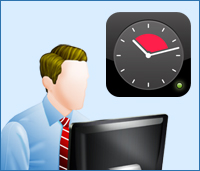Employee time tracking is dead

iBeacons, Bluetooth Low Energy, Proximity sensing and the obsolescence of time tracking as we know it.
Businesses have to track the time their employees work for a variety of reasons, the most important of which is to pay them correctly or bill clients accurately. Today, there are various means and devices used to achieve this: paper punch cards, handwritten sheets of paper, spreadsheets, online software, and time clocks, to name a few. Most of these methods have been in use for several decades, and all of them have one critical point of failure—the employee—upon whom the onus of tracking work time almost always falls. Employees may sometimes forget to log their time, or put it off until the deadline. In both cases, the result is inaccurate work time data, which leads to errors in payroll, invoices, and possibly even lawsuits. Tracking time is often a tedious, annoying, and frustrating task that an employee needs to do several times over the course of a workweek, in addition to his or her actual work. As with most tasks that share these characteristics, they get put off until the last minute, or simply forgotten.
At Replicon, we think time tracking should not be an annoying and burdensome task. In fact, we think that time tracking should not be a task at all!
One recent innovation that is hitting the markets is proximity sensing technology such as Apple’s iBeacon or what’s generically called Bluetooth Low Energy (BLE) or Smart Bluetooth. iBeacon and BLE provide a way to detect how close someone is to a specific location or object and do useful things when that happens. Two components are involved in proximity sensing: a transmitter and a receiver. The iBeacon is a transmitter that broadcasts its location via bluetooth. There are receivers that can be programmed to to do specific tasks when they sense one of these iBeacons at a specified distance.
iBeacons and BLE devices offer great opportunities to eliminate time tracking as a task that employees have to do. They also offer other interesting applications.
Picture this: A modern car manufacturer with a diverse workforce comprised of factory plant workers, office staff and roaming security staff. Each employee carries a company ID badge that is fitted with an iBeacon.
Unobtrusive Time Tracking
At the factory, employees walk in at the start of their shift. As they walk through the entrance of the plant, their iBeacon signatures are detected and their start time and location are recorded. Employees are required to take breaks, and when they do this, they usually walk into break rooms or go out of the facility. Strategically positioned iBeacon receivers will detect patterns of movement and register when employees are no longer at their work locations, and their time tracking can be paused, and breaks can be recorded automatically.
Controlled Access
At the same factory, only employees with special certifications are allowed to operate specialized welding robots. Besides controlling who gets to use these machines, the company also wants to know how much time employees spend at each one. When an employee walks up to the welding robot, it detects his iBeacon, and his employee profile is immediately checked for current certifications. If everything is in order, the robot starts operating. When the employee steps away from the robot, the time spent is automatically logged, and the machine turns itself off.
Office Staff
This car manufacturer has a design team which operates at special workstations. When a designer walks up to her desk, her computer detects her iBeacon and informs her that it is ready to start logging her work time. When she steps away from her desk to take a break, her computer will automatically pause the time logging.
Employee Locator
The plant’s security manager needs to know where his security personnel are at all times. He opens up his iPad and can see a map of the plant and campus. On this map he can see the specific locations where his people are at that instant. He can see this because his security officers’ iBeacons will be reporting location to strategically positioned receivers. The manager can now accurately determine where his staff are, and also how much time they are spending at various spots.
We live in an age where smart watches and wristbands let us know how much we exercised during the day, or how well we slept the previous night. Smartphones tell us our precise location at all times. Cars can unlock doors and start without keys. Thermostats turn down the heat when they sense no one moving in the house. All these innovations are now possible with the maturing of advanced sensors, powerful computers masquerading as phones and tablets, and ubiquitous network connectivity. While most of these innovations have been targeted at the consumer market, we see a lot of potential for this technology in the business arena.
Time and Attendance vendors have historically lacked an innovative zeal. In 2011, Replicon introduced CloudClock, a tablet-based punch clock. We challenged the established paradigm of monolithic, expensive, and clunky time clocks. We brought the benefits of cloud-based software to physical location-based time tracking. As we move through 2014 and 2015, we are looking to challenge the very idea of time tracking itself, by incorporating the latest and greatest technologies in our product lineup.
Stay tuned for the latest advances from Replicon.






